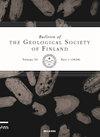芬兰酸性硫酸盐土壤的绘图、影响、特征和范围
IF 1.3
4区 地球科学
Q2 GEOLOGY
引用次数: 1
摘要
酸性硫酸盐土壤(ASS)会在含硫物质氧化过程中形成硫酸,导致土壤酸度极高(pH 值小于 4.0),从而在全球范围内造成严重问题。其影响包括土壤和水的酸化、金属的沥滤、养分供应的减少、水生动植物的退化以及基础设施的腐蚀。这些土壤的岩土特性也很差。芬兰是欧洲 ASS 分布最多的国家,主要分布在波罗的海沿岸。欧盟水框架指令》促使各方广泛合作,以减少 ASS 对芬兰的有害影响。当务之急是确定 ASS 的分布地点和特征。由芬兰地质调查局(GTK)领导的这项长达 10 多年的计划于 2009 年启动,实地工作于 2021 年完成。计划期间,在 5 010 000 公顷面积上的 23 000 个地点进行了观察、测量、取样和分析。传统上,芬兰的 ASS 被认为由细粒硫酸盐沉积物和/或其氧化层组成,出现在利托里纳海横断面最高海岸线以下沿岸的农田中。这项研究确认了其他类型潜在有害 ASS 物质的大量出现,并对其进行了分类:(1) 粗粒 ASS(沙),(2) 有机 ASS(泥炭)和 (3) 未分类 ASS(耕层物质)。我们对芬兰 ASS 的方法、定义和分类进行了修订。根据我们的计算,沿岸的 ASS 面积约为 1 000 000 公顷,相当于过去利托里纳海覆盖面积的 21%,是之前估计的 3 到 6 倍。此外,内陆也发现了一些 ASS,主要与黑色页岩和硫化矿有关。绘图数据可通过 GTK 地图服务(www.gtk.fi)访问,提供有关 ASS 分布和特性的信息。本文章由计算机程序翻译,如有差异,请以英文原文为准。
Mapping, impacts, characterization and extent of acid sulfate soils in Finland
Acid sulfate soils (ASS) cause big problems worldwide due to their potential to form sulfuric acid during oxidation of sulfidic materials, resulting in very acid soil (pH <4.0). Impacts include acidification of soil and water, leaching of metals, decreased nutrient supply, deterioration of water fauna and flora, and corrosion of infrastructure. These soils also exhibit poor geotechnical properties. Finland has the largest occurrences of ASS in Europe, mainly along the coast of the Baltic Sea. The EU Water Framework Directive brought about wide co-operation to reduce the harmful impacts of ASS in Finland. One urgent step was to localize and characterize the occurrences of ASS. The more than 10 year-long programme, led by the Geological Survey of Finland (GTK), started in 2009 and field work was completed in 2021. During the programme observations, measurements, sampling and analyses were made at 23 000 sites in an area of 5 010 000 ha. Traditionally ASS in Finland have been considered to comprise fine-grained sulfidic sediments and/or their oxidized layers, occurring on agricultural land along the coast below the highest shoreline of the Littorina Sea transgression. This study recognized and classified significant occurrences of other types of potentially harmful ASS materials: (1) coarse-grained ASS (sand), (2) organic ASS (peat) and (3) unsorted ASS (till material). The methods, definition and classification of Finnish ASS have been revised. We calculated the extent of ASS along the coast to be about 1 000 000 ha corresponding to 21% of the area covered in the past by the Littorina Sea, and three to six times more than earlier estimates. In addition, some occurrences of ASS were recognized inland, mainly related to black shales and sulfidic ores. The mapping data can be accessed via the GTK map service (www.gtk.fi) providing information about the distribution and properties of ASS.
求助全文
通过发布文献求助,成功后即可免费获取论文全文。
去求助
来源期刊
CiteScore
1.30
自引率
0.00%
发文量
5
审稿时长
>12 weeks
期刊介绍:
Bulletin of the Geological Society of Finland (BGSF) publishes research articles and short communications in all branches of geosciences. Contributions from outside Finland are welcome, provided that they contain material relevant to Finnish geology or are of general interest.

 求助内容:
求助内容: 应助结果提醒方式:
应助结果提醒方式:


